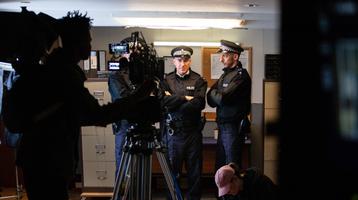News Story
Commissioned by BFI NETWORK, Blue Bottle is a silent animation that tells a story of comfort, abandonment and independence in its own unique way. This universal story is beautifully brought together using 2D animation, score and sound design. We interviewed the team behind Blue Bottle: Tribeca award winning director & animator Jenny Wright, and writer & producer Jake Cunningham.
To keep up with news about Blue Bottle, follow Jenny Wright on Instagram at @hellojennywright and Jake Cunningham on Twitter at @jakehcunningham and Instagram at @jake.h.cunningham
View more of Jenny Wright’s work here.
Listen to Jake’s Ghibliotheque podcast here.
What was your journey into animation and the film industry like?
Jenny Wright: When I graduated from Central Saint Martins, the first year was predominantly filled with following my graduation film My Mother’s Eyes to festivals. That film felt like my entire portfolio at the time and was my pass into the industry. Finding the independent animation world was exciting and I’ve been settling in for the last three years; now with a wider portfolio accompanied with a desire to keep learning and improving.
Jake Cunningham: I used to sell car insurance, but after three years of that I had to get out and do something I loved, so I studied film at the University of Kent. I was lucky enough to work at a cinema whilst there, which led to working at the chain’s London office, making a podcast for them and getting into writing about film. Next I became a commissioning assistant on Channel 4’s short form arts strand Random Acts, working on up to 120 shorts a year, now I make podcasts full time with a specialism in film and TV, as well as being a freelance writer and producer as well.
Blue Bottle explores universal and important themes through water colour style animation, and an endearing water bottle character. Tell us more about your BFI NETWORK supported short and the inspiration behind it ?
JW: This will be more of a question for Jake because he wrote Blue Bottle! Although, we did work together on developing the story from a typed A4 page into a short animation script which allowed me to understand Jake’s intentions. Design wise, there were a few Matisse paintings that I drew on for colour inspiration. Animation wise, I always look back to Michael Dudok De Wit’s films. To elevate the core messages of the film we wanted every part of the design to be necessary and anything we could take out we did.
JC: I came up with the idea, like so many writers do, when I couldn’t sleep. When I was young, my parents would make me a hot water bottle every night during winter, something I’ve carried on doing for myself and my partner. When I was lying awake one night, the hot water bottle keeping my feet warm, I started thinking about the relationship between human and hot water bottle and how I controlled every aspect of its being - then I wondered what, if it were to exist, what an independent, sentient hot water bottle would do with its life, if it wasn’t under my control. When I wrote it down, it sounded more like maybe I was dreaming, but I’m sure I wasn’t. I think.
From a stylistic point of view, over the last few years I’ve been on an odyssey into the worlds of Studio Ghibli (I’ve even co-written a book about it) and fell in love with the works of Isao Takahata. He would often strip back the frames of the image to only the most essential elements, pouring as much emotion and story into the simplest images, leaving the edges of the screen totally blank. His work on Only Yesterday, My Neighbors the Yamadas and The Tale of the Princess Kaguya was a big inspiration to me - and something I shared with Jenny when we were developing the look of the film.
Why do you feel stories like this are important?
JW: Universal themes allow us to connect to others. Animation can give us space to observe with a distance from our own lives and in doing so a space for thought. For me, this story became about slowing down, amongst the other themes. If it just allows the viewer seven minutes to stop and be peaceful then I'd consider that a success. Many of us have had more than seven minutes to slow down this year and hopefully, if nothing else, this character can be a comforting companion in moments and periods of pain.
JC: We wanted the film to offer gentle reassurance and comfort, something that hot water bottles themselves do. With its soft rhythm and deliberate pacing, we’re inviting audiences to not just reflect on our character but to have the opportunity to make space for their own thoughts too, interpreting the emotions of the story in whatever the most valuable way for them might be personally.
How has your experience working in animation inspired you as a storyteller?
JW: Studying and then working in animation inspired me to be a storyteller. It was not something I thought about much before that. Experiencing how animation can reach people has been wonderful. I hope to tell many more stories whether it’s my own or other peoples.
JC: Working with Jenny has shown me how valuable collaboration is in storytelling. Although the story may have originated with me, I am not an animator, I can barely draw a stick-man, it was shaped in the animation and reworked to offer new expressions and interpretations through Jenny’s work, something I could have never done.
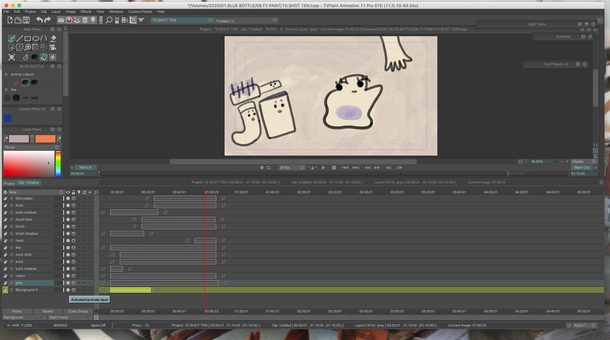
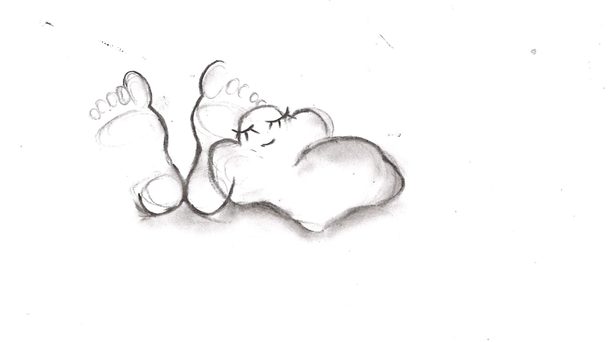
What was the storyboarding process like, how did you prepare the animatic and character design?
JW: There was a considerable amount of shifting and swapping parts of the story around and we had allowed and planned for this time. The bottle and feet designs both materialised quite quickly and then I spent a week or so drawing them over and over again on paper before moving to a computer.
JC: Not being able to draw myself, this was all down to Jenny and she did an incredible job. It was amazing to see this fairly abstract idea come to life in her style, from the first sketches, to the animatic, to the final animation.
You also collaborated with sound designer Ben Goodall and composer Anthony Ing. What was it like working together to bring this animation to life?
JW: I’ve worked with Ben a lot since he did the sound design on My Mother’sEyes and it is always very rewarding. Sound elevates animations hugely. Working with Ant for the first time was exciting and he brought a lot to the story with his score.
JC: Ben and Ant really had an uphill battle with this and both of them did a superb job. It’s not an easy thing to translate emotion through the different wobbles, gurgles and slushes that water can make and it was incredible to hear Ben manage that through his sound design. For the score, Ant managed to create this cascading sense of life being poured into the hot water bottle, followed by a real sense of serenity, tinged with fear and insecurity, that was just what we imagined. It was clear he was the right man for the job from the very first samples he sent.
Can you talk us through a particular moment in your short?
JW: The repetition of the smoke that punctures the moments between each interaction is one of the sections of animation that I am most fond of both aesthetically and for its function in the story. Originally a sun and a moon; we realised we could remove this extra element and instead draw upon the kettle at the start and make it into a motif. Often I find looking back at the world you have created can solve a section of the story but sometimes you have to make something else and delete it before getting to that final, usually simple, solution.
JC: I have two, if that’s ok. The first is the moment that the hot water bottle’s eyes first pop up, when I watched that for the first time it was like seeing the first steps of our project, and it assured me that our anthropomorphic hot water bottle could have it’s own full and expressive life. The second is when it glides through the air in love with the feet of its creator. That was improvised by Jenny and I think it’s a beautiful piece of animation, that’s rich in style and emotion.
What are your plans upon the release of Blue Bottle?
JW: We have a few little festivals that Blue Bottle will be attending but we are waiting on more & very much hoping Covid won’t stop us, and our hot water bottle, enjoying the festival circuit.
JC: Then once we’ve taken that journey, we’re looking forward to the film living online and hopefully finding a global audience who can settle in and relax with it.
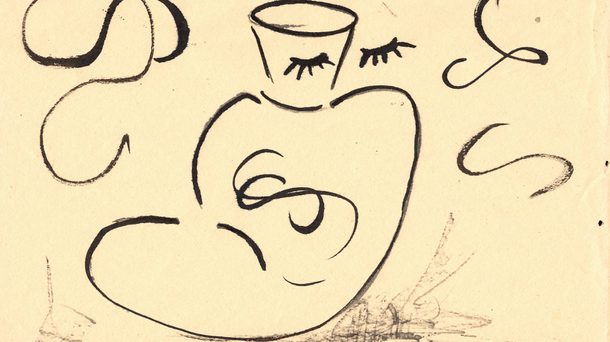
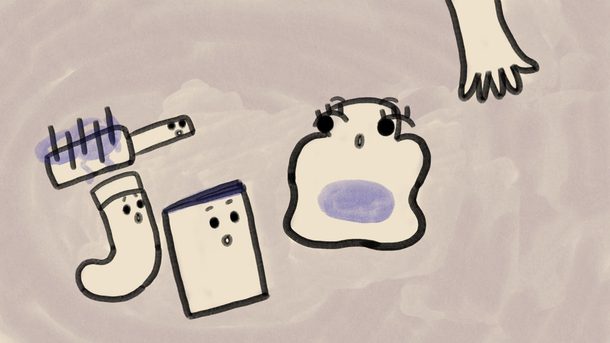
What are you hoping the audience will get out of it?
JW: A moment of peace and reflection. Enjoyment in identifying with Blue Bottle, the emotional journey and interpreting the story however they please.
JC: And for anyone watching who’s looking for an animator, I’d hope they’d know who to be calling…
What are you currently working on, and how are you navigating the COVID situation and keeping engaged and balanced?
JW: I’m currently working on animations for a theatre production, an online greetings card company and hopefully starting a new music video soon. I am navigating the COVID situation by taking things day by day and gardening.
JC: I’ve been working from home this whole time, which has been both a privilege and a challenge and having Blue Bottle to work on with Jenny during lockdown is one of the things that helped me through it. In the last few months I’ve been putting together an animated feature film development proposal, as well as getting more writing out there, most recently for The I and Little White Lies.
What advice would you give to filmmakers embarking on making their animated short film right now?
JW: Apply for grants! Focus on the intention of your short and its story. Make sure you can write this down in one sentence. Enjoy animating; it doesn’t have to be a painstaking process. Saying that, Blue Bottle (being made during the pandemic) is probably the film I’ve put the most time into. Partially as a result of having so much of it, time that is.
JC: Jenny’s absolutely right. Even if you don’t get the grant you’re applying for, the process of writing about your film for an application can be hugely valuable. It’s an opportunity for you to understand its story, its style and its values. These things might be clear in your head, but putting them on the page can be massively helpful once you do enter production. I’d also like to emphasise the importance of your collaborators and to see them as such. None of us had 100% clarity on what the final film would be, it's through working with your crew that you collectively work towards that goal, and by surrounding ourselves with trusted, talented and enthusiastic people we got there in the end.
If you’d like to make a short film, we can help!
Find out more about the BFI NETWORK Short Film Fund. Need inspiration? Check out our Vimeo channel.
Want to find out more about our events programme for emerging filmmakers in London? Follow us on Twitter and Instagram
